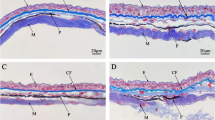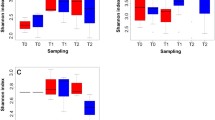Abstract
Amphibian’s skin bacterial community may help them to cope with several types of environmental perturbations, including osmotic stress caused by increased salinity. This work assessed whether an amphibian skin bacterium could increase its tolerance to NaCl after a long-term exposure to this salt. A strain of Erwinia toletana, isolated from the skin of Pelophylax perezi, was exposed to two salinity scenarios (with 18 g/L of NaCl): (1) long-term exposure (for 46 days; Et-NaCl), and (2) long-term exposure followed by a recovery period (exposure for 30 days to NaCl and then to LB medium for 16 days; Et-R). After exposure, the sensitivity of E. toletana clonal populations to NaCl was assessed by exposing them to 6 NaCl concentrations (LB medium spiked with NaCl) plus a control (LB medium). Genotypic alterations were assessed by PCR-based molecular typing method (BOX-PCR). The results showed that tolerance of E. toletana to NaCl slightly increased after the long-term exposure, EC50 for growth were: 22.5 g/L (8.64–36.4) for Et-LB; 30.3 g/L (23.2–37.4) for Et-NaCl; and 26.1 g/L (19.332.9) for Et-R. Differences in metabolic activity were observed between Et-LB and Et-R and between Et-NaCl and Et-R, suggesting the use of different substrates by this bacterium when exposed to salinized environments. NaCl-induced genotypic alterations were not detected. This work suggests that E. toletana exposed to low levels of salinity, activate different metabolic pathways to cope with osmotic stress. These findings may be further explored to be used in bioaugmentation procedures through the supplementation with this bacterium of the skin microbiome of natural populations of amphibians exposed to salinization.




Similar content being viewed by others
Data availability
The datasets from the current study are available from the corresponding author on request.
References
Baumann K, Marschner P (2013) Effects of salinity on microbial tolerance to drying and rewetting. Biogeochemistry 112:71–80. https://doi.org/10.1007/s10533-011-9672-1
Becker MH, Brucker RM, Schwantes CR et al (2009) The bacterially produced metabolite violacein is associated with survival of amphibians infected with a lethal fungus. Appl Environ Microbiol 75:6635–6638. https://doi.org/10.1128/AEM.01294-09
Beebee TJC, Griffiths R (2005) The amphibian decline crisis: a watershed for conservation biology? Biol Conserv 125:271–285. https://doi.org/10.1016/j.biocon.2005.04.009
Bernabò I, Bonacci A, Coscarelli F et al (2013) Effects of salinity stress on Bufo balearicus and Bufo bufo tadpoles: tolerance, morphological gill alterations and Na+/K+-ATPase localization. Aquat Toxicol 132–133:119–133. https://doi.org/10.1016/j.aquatox.2013.01.019
Bletz MC, Loudon AH, Becker MH et al (2013) Mitigating amphibian chytridiomycosis with bioaugmentation: characteristics of effective probiotics and strategies for their selection and use. Ecol Lett 16:807–820. https://doi.org/10.1111/ele.12099
Cañedo-Argüelles M, Kefford BJ, Piscart C et al (2013) Salinisation of rivers: an urgent ecological issue. Environ Pollut 173:157–167. https://doi.org/10.1016/j.envpol.2012.10.011
Colombo BM, Scalvenzi T, Benlamara S, Pollet N (2015) Microbiota and mucosal immunity in amphibians. Front Immunol 6:1–15. https://doi.org/10.3389/fimmu.2015.00111
Costa S, Lopes I, Proença DN et al (2016) Diversity of cutaneous microbiome of Pelophylax perezi populations inhabiting different environments. Sci Total Environ 572:995–1004. https://doi.org/10.1016/j.scitotenv.2016.07.230
Dhar R, Sägesser R, Weikert C et al (2011) Adaptation of Saccharomyces cerevisiae to saline stress through laboratory evolution. J Evol Biol 24:1135–1153. https://doi.org/10.1111/j.1420-9101.2011.02249.x
Estévez E, Rodríguez-Castillo T, González-Ferreras AM, Cañedo-Argüelles M, Barquín J (2019) Drivers of spatio-temporal patterns of salinity in Spanish rivers: A nationwide assessment. Philos Trans R Soc B Biol Sci 374:1–10. https://doi.org/10.1098/rstb.2018.0022
Geider K, Auling G, Du Z et al (2006) Erwinia tasmaniensis sp. nov., a non-phytopathogenic bacterium from apple and pear trees. Int J Syst Evol Microbiol 56:2937–2943. https://doi.org/10.1099/ijs.0.64032-0
Görke B, Stülke J (2008) Carbon catabolite repression in bacteria: many ways to make the most out of nutrients. Nat Rev Microbiol 6:613–624. https://doi.org/10.1038/nrmicro1932
Grattieri M, Beaver K, Gaffney EM, Minteer SD (2019) Tuning purple bacteria salt-tolerance for photobioelectrochemical systems in saline environments. Faraday Discuss 215:15–25. https://doi.org/10.1039/c8fd00160j
Guckert JB, Carr GJ, Johnson TD, Hamm BG, Davidson DH, Kumagai Y (1996) Community analysis by Biolog: curve integration for statistical analysis of activated sludge microbial habitats. J Microbiol Methods 27:183–197. https://doi.org/10.1016/S0167-7012(96)00948-7
Harris RN, Brucker RM, Walke JB et al (2009) Skin microbes on frogs prevent morbidity and mortality caused by a lethal skin fungus. ISME J 3:818–824. https://doi.org/10.1038/ismej.2009.27
He H, Chen Y, Li X et al (2016) Influence of salinity on microorganisms in activated sludge processes: a review. Int Biodeterior Biodegrad 119:520–527. https://doi.org/10.1016/j.ibiod.2016.10.007
Holden WM, Hanlon SM, Woodhams DC et al (2015) Skin bacteria provide early protection for newly metamorphosed southern leopard frogs (Rana sphenocephala) against the frog-killing fungus, Batrachochytrium dendrobatidis. Biol Conserv 187:91–102. https://doi.org/10.1016/j.biocon.2015.04.007
How JA, Lim JZR, Goh DJW, Ng WC, Oon JSH, Lee KC, Lee CH, Ling MHT (2013) Adaptation of Escherichia coli ATCC 8739 to 11% NaCl. Dataset Pap Biol 2013:1–7. https://doi.org/10.7167/2013/219095
Huang CJ, Lin H, Yang JX (2015) A robust method for increasing Fc glycan high mannose level of recombinant antibodies. Biotechnol Bioeng 112:1200–1209. https://doi.org/10.1002/bit.25534
Jahnke JP, Terrell JL, Smith AM et al (2016) Influences of adhesion variability on the ‘living’ dynamics of filamentous bacteria in microfluidic channels. Molecules 21:985. https://doi.org/10.3390/molecules21080985
Kirwan ML, Megonigal JP (2013) Tidal wetland stability in the face of human impacts and sea-level rise. Nature 504:53–60. https://doi.org/10.1038/nature12856
Kueneman JG, Parfrey LW, Woodhams DC et al (2014) The amphibian skin-associated microbiome across species, space and life history stages. Mol Ecol 23:1238–1250. https://doi.org/10.1111/mec.12510
Ma Y, Galinski EA, Grant WD et al (2010) Halophiles 2010: life in saline environment. Appl Environ Microbiol 76:6791–6981. https://doi.org/10.1128/AEM.01868-10
Margesin R, Schinner F (2001) Potential of halotolerant and halophilic microorganisms for biotechnology. Extremophiles 5:73–83. https://doi.org/10.1007/s007920100184
Mccoy MW (2017) Adaptive responses to salinity stress across multiple life stages in anuran amphibians. Front Zool 4:1–16. https://doi.org/10.1186/s12983-017-0222-0
McKenzie VJ, Bowers RM, Fierer N et al (2012) Co-habiting amphibian species harbor unique skin bacterial communities in wild populations. ISME J 6:588–596. https://doi.org/10.1038/ismej.2011.129
Miliute I, Buzaite O, Baniulis D, Stanys V (2015) Bacterial endophytes in agricultural crops and their role in stress tolerance: a review. Zemdirbyste 102:465–478. https://doi.org/10.13080/z-a.2015.102.060
Mills AAS, Platt HW, Hurta RAR (2006) Sensitivity of Erwinia spp. to salt compounds in vitro and their effect on the development of soft rot in potato tubers in storage. Postharvest Biol Technol 41:208–214. https://doi.org/10.1016/j.postharvbio.2006.03.015
Mulamba T, Bacopoulos P, Kubatko EJ, Pinto GF (2019) Sea-level rise impacts on longitudinal salinity for a low-gradient estuarine system. Clim Change 152:533–550. https://doi.org/10.1007/s10584-019-02369-x
Muñoz-elías EJ, Mckinney JD (2006) Carbon metabolism of intracellular bacteria. Cell Microbiol 8:10–22. https://doi.org/10.1111/j.1462-5822.2005.00648.x
Oren A (2008) Microbial life at high salt concentrations: phylogenetic and metabolic diversity. Saline Syst 13:1–13. https://doi.org/10.1186/1746-1448-4-2
Payen S, Basset-Mens C, Núñez M et al (2016) Salinisation impacts in life cycle assessment: a review of challenges and options towards their consistent integration. Int J Life Cycle Assess 21:577–594. https://doi.org/10.1007/s11367-016-1040-x
Pereira DT, Simioni C, Ouriques LC, Ramlov F, Maraschin M, Steiner N, Chow F, Bouzon ZL, Schmidt C (2018) Comparative study of the effects of salinity and UV radiation on metabolism and morphology of the red macroalga Acanthophora spicifera (Rhodophyta, Ceramiales). Photosynthetica 56:799–810. https://doi.org/10.1007/s11099-017-0731-2
Qurashi AW, Sabri AN (2013) Osmolyte accumulation in moderately halophilic bacteria improves salt tolerance of chickpea. Pak J Bot 45:1011–1016
Rojas A, García de los Rios JE, Fischer-Le Saux M et al (2004a) Erwinia toletana sp. nov., associated with Pseudomonas savastanoi-induced tree knots. Int J Syst Evol Microbiol 54:2217–2222. https://doi.org/10.1099/ijs.0.02924-0
Santos B, Ribeiro R, Domingues I, Pereira R, Soares AMVM, Lopes I (2013) Salinity and copper interactive effects on Perez's frog Pelophylax perezi. Environ Toxicol Chem 32:1864–1872. https://doi.org/10.1002/etc.2257
Saum SH, Müller V (2007) Salinity-dependent switching of osmolyte strategies in a moderately halophilic bacterium: glutamate induces proline biosynthesis in Halobacillus halophilus. J Bacteriol 189:6968–6975. https://doi.org/10.1128/JB.00775-07
Schelegueda LI, Zalazar AL, Gliemmo MF, Campos CA (2016) Inhibitory effect and cell damage on bacterial flora of fish caused by chitosan, nisin and sodium lactate. Int J Biol Macromol 83:396–402. https://doi.org/10.1016/j.ijbiomac.2015.11.033
Schröder C, Selig M, Schönheit P (1994) Glucose fermentation to acetate, CO2 and H2 in the anaerobic hyperthermophilic eubacterium Thermotoga maritima: involvement of the Embden-Meyerhof pathway. Arch Microbiol 161:460–470. https://doi.org/10.1007/BF00307766
Silva DP, Castañeda-Ojeda MP, Moretti C et al (2014) Bacterial multispecies studies and microbiome analysis of a plant disease. Microbiology 160:556–566. https://doi.org/10.1099/mic.0.074468-0
Stănescu F, Székely D, Székely P, Topliceanu S, Cogălniceanu D (2017) The impact of salinity on early developmental stages in two sympatric spadefoot toads and implications for amphibian conservation in coastal areas. Hydrobiologia 792:357–366. https://doi.org/10.1007/s10750-016-3074-2
Stefanowicz A (2006) The biolog plates technique as a tool in ecological studies of microbial communities. Polish J Environ Stud 15:669–676
Touzé T, Goude R, Georgeault S et al (2004) Erwinia chrysanthemi O antigen is required for betaine osmoprotection in high-salt media. J Bacteriol 186:5547–5550. https://doi.org/10.1128/JB.186.16.5547-5550.2004
Venâncio C, Ribeiro R, Lopes I (2020) Active emigration from climate change-caused seawater intrusion into freshwater habitats. Environ Pollut 258:113805. https://doi.org/10.1016/j.envpol.2019.113805
Waditee-Sirisattha R, Kageyama H, Takabe T (2016) Halophilic microorganism resources and their applications in industrial and environmental biotechnology. AIMS Microbiol 2:42–54. https://doi.org/10.3934/microbiol.2016.1.42
Wang H, Li HX, Fang F, Guo J-S, Chen YP, Yan P, Yang JX (2019) Underlying mechanisms of ANAMMOX bacteria adaptation to salinity stress. J Ind Microbiol Biotechnol 46:573–585. https://doi.org/10.1007/s10295-019-02137-x
Wang H, Wang L, Yang H et al (2015) Comparative proteomic insights into the lactate responses of halophilic salinicoccus roseus W12. Sci Rep 5:1–11. https://doi.org/10.1038/srep13776
Woodhams DC, Brandt H, Baumgartner S et al (2014) Interacting symbionts and immunity in the amphibian skin mucosome predict disease risk and probiotic effectiveness. PLoS ONE 9:e96375. https://doi.org/10.1371/journal.pone.0096375
Woodhams D, Bletz M, Kueneman J, McKenzie V (2016) Managing amphibian disease with skin microbiota. Trends Microbiol 24:161–164. https://doi.org/10.1016/j.tim.2015.12.010
Zhou A, Baidoo E, He Z et al (2013) Characterization of NaCl tolerance in Desulfovibrio vulgaris Hildenborough through experimental evolution. ISME J 7:1790–1802. https://doi.org/10.1038/ismej.2013.60
Acknowledgements
This work was supported by the project Generosi (PTDC/BIA-BIC/3488/2012—FCOMP01-0124-FEDER-028278) funded by FEDER, through COMPETE2020—Programa Operacional Competitividade e Internacionalização (POCI), and by national funds (OE) and by CESAM (UIDB/50017/2020 + UIDP/50017/2020), through FCT/MCTES through national funds.
Author information
Authors and Affiliations
Contributions
AG: conceptualization, methodology, formal analysis, investigation, writing: original draft. SC: methodology, investigation. IH: conceptualization, writing review and editing, resources. IL: conceptualization, funding acquisition, resources, supervision, writing: review and editing project administration.
Corresponding author
Ethics declarations
Conflict of interest
The authors declare that they have no conflict of interest.
Consent for publication
The authors have no conflict of interest to be reported, and the manuscript was approved by all authors for submission. Furthermore, I declare, on behalf of co-authors, that this work has original research that has not been published previously, and not under consideration for publication elsewhere, in whole or in part.
Rights and permissions
About this article
Cite this article
Gabriel, A., Costa, S., Henriques, I. et al. Effects of Long-Term Exposure to Increased Salinity on the Amphibian Skin Bacterium Erwinia toletana. Arch Environ Contam Toxicol 80, 779–788 (2021). https://doi.org/10.1007/s00244-021-00845-z
Received:
Accepted:
Published:
Issue Date:
DOI: https://doi.org/10.1007/s00244-021-00845-z




